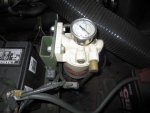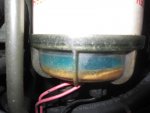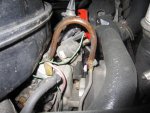I added a large spin on Racor 90P filter to my M1008 and installed it between the tank and lift pump. The filter body and bowl will accept a bunch of different cartiges, small / med / large and also 30 micron / 10 micron / 2 micron. The reason for this location was that the filter would also protect the lift pump from debries in this position. I put a vacuum gage on the filter as well to monitor the degree of clogging the filter had, new it was 0" HG, fully clogged it would be 7-10" Hg. The idea was to change out the filter when I got to about 5" Hg on the gage. What I found is that it was more of an effort to drain crud and water out of the bottom of the filter when installed this way. You would have to shut the engine off, open the bottom filter drain, get the crud out, close the drain, then bleed out the air through the bleeder on the stock filter in the normal way. This is because as soon as you opened up the drain air would be sucked in by the lift pump. I then moved the filter so it was after the lift pump and before the stock filter and Injector pump. In this position I can just open up the drain when the engine is running and all the crud is forced out from the bottom of the filter under lift pump fuel pressure. There is no need to bleed anything in this case a 15 second job. The other reason that I like the filter here is that the fuel is under pressure when forced through the filter which should be better at low temps. When the filter is before the lift pump you can only suck until you draw a vacuum.
I also installed the racor heater kit for this filter which helps when it is very cold out. I can say the filter seperated out lots of water very well when installed in either location, see pic of the bowl.
In all the large marine diesel engines I have worked on the large Racor turbine type filter (20 micron pre-filter and water seperator) is always installed between the tank and the lift pump. The secondary cartriage filters (2 micron) are installed between the lift pump and the injector pump. I am mentioning this because the turbine type filters work well on the suction side and protect the lift pump as well when set up this way. In effect this is the better set up but as I mentioned above, less convienent.
I found that using a piece of clear tygon fuel tubing for the short piece of hose on top of the injector pump going to the return line allow you to see any bubbles going through the system. This has helped rule out fuel issues when troubleshooting on the road. The piece in the picture is about 5 years old.
Hope this helps.





